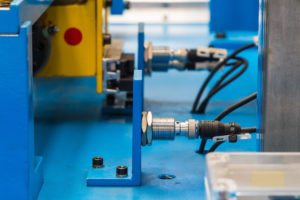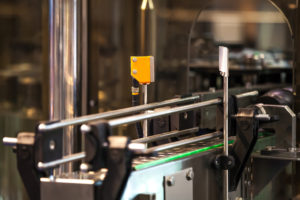What Type of Sensor Do I Need?
With all of the different types of sensors available today, it can be difficult to know for sure which type of sensor will fit your application the best. In the world of sensing, there is often not one right answer. This can open the door to a variety of different solutions that will work with your project, but with a few application considerations, you can choose a sensor that will be accurate, reliable and possibly economical over the life of the product.
The three most common type of sensors used in industrial applications are proximity sensors, ultrasonic sensors, and photoelectric sensors. Let’s take a look at the differences between these and why one might be better than another in certain applications.
Proximity Sensors-
 There are many subcategories that fall under the proximity sensor umbrella. Capacity sensors and inductive sensors are just to name a few.
There are many subcategories that fall under the proximity sensor umbrella. Capacity sensors and inductive sensors are just to name a few.
Inductive proximity sensors are the preferred choice for the majority of applications requiring accurate, non-contact detection of metallic objects in machinery or automation equipment. Inductive sensors are usually offered in a variety of different housing styles and sensing ranges making them extremely versatile in different applications. Some typical applications include positioning, robotics, or conveyors where the object of detection is metallic.
Capacitive sensors can be used to detect metal objects as well as nearly all other materials. These sensors are often used in applications including level, flow control for detection of liquids, grains and powders.
Capacitive sensors are also offered in cylindrical and surface mountable housings.
Ultrasonic Sensors-
In industrial applications, ultrasonic sensors are characterized by their reliability and outstanding versatility. Ultrasonic sensors can be used to solve even the most complex tasks involving object detection or level measurement with millimeter precision, because their measuring method works reliably under almost all conditions. No other measuring method can be successfully put to use on such a wide scale and in so many different applications. The devices are extremely robust, making them suitable for even the toughest conditions. The sensor surface cleans itself through vibration, and that is not the only reason why the sensor is insensitive to dirt. The physical principle—the propagation of sound—works, with a few exceptions, in practically any environment. Gone are the days where ultrasonic sensors are viewed as the measuring method only used as a “last resort” … as a solution for particularly difficult applications. Ultrasonic sensors have proven their reliability and endurance in virtually all industrial sectors.
These sectors include:
- Mechanical engineering/machine tool
- Food and beverage
- Woodworking and furniture
- Building materials
- Agriculture
- Construction
- Pulp and paper
- Material handling
- Level measurement
Photoelectric Sensors-
 The broad ranges of photoelectric sensors are aimed at all automation solutions where noncontact object detection can be utilized. The wide variety of different operating principles, models, sizes and specifications means that the best possible sensor can always be found for the relevant application and all conditions that occur in practice can be met. A photoelectric sensor emits a light beam (visible or infrared) from its light-emitting element to either a receiver (thru-beam), reflective device which is then transmitted back to the emitting/receiving element (Retroreflective), or the light beam is reflected from the actual target of detection and sent back to the emitting/receiving element so no reflective device is needed(diffuse mode). Which model to select will depend on what you are sensing and what kind of mounting restrictions exist with your project.
The broad ranges of photoelectric sensors are aimed at all automation solutions where noncontact object detection can be utilized. The wide variety of different operating principles, models, sizes and specifications means that the best possible sensor can always be found for the relevant application and all conditions that occur in practice can be met. A photoelectric sensor emits a light beam (visible or infrared) from its light-emitting element to either a receiver (thru-beam), reflective device which is then transmitted back to the emitting/receiving element (Retroreflective), or the light beam is reflected from the actual target of detection and sent back to the emitting/receiving element so no reflective device is needed(diffuse mode). Which model to select will depend on what you are sensing and what kind of mounting restrictions exist with your project.
The emitter and receiver on thru-beam sensors are aligned opposite one another. The advantage of this is that the light reaches the receiver directly and long detection ranges and high excess gain can therefore be achieved. These sensors are capable of reliably detecting almost any object. The angle of incidence, surface characteristics, color of the object, etc., are irrelevant and do not influence the functional reliability of the sensor, whereas, retroreflective sensors the emitter and receiver are aligned in a housing such that the retroreflective sensors are easy to install. Simply position a reflector on the opposite side and align the sensor with it. The standard version featuring a polarization filter combines the installation benefits offered by the retroreflective system with the reliable detection, even of reflective objects, at long detection ranges. The retroreflective sensors for clear object detection are ideal for reliably detecting transparent objects.
Looking to detect small objects at a close range and a reflector is not necessary? Diffuse mode sensors are particularly easy to install, since only one device has to be fitted and no reflector is required. These sensors operate primarily at close range, feature optimum switching accuracy, and can reliably detect even very small objects. The sensors with background suppression sense only a specific area in front of the sensor. The sensor ignores any objects that are outside of this area. Sensors with background suppression are also insensitive to interfering objects in the background and are still extremely precise. Sensors with background evaluation are always used in applications with a fixed background in the measuring range with which you can align the sensor.
So now that we have seen a variety of different sensing options, you may be asking what types of sensors will work well for my application? Let’s start with asking some application specific questions to establish what exactly it is that we are trying to accomplish:
What type of sensing am I trying to do?
Are you sensing a process parameter (e.g. temperature, pressure, flow), the presence of an object, the distance to a target, or the position of a mechanism? This aspect can play into which model to focus on.
What is the composition of the target?
Is it metallic, non-metallic, solid, liquid, granular? Is it transparent, or is it a colored object? What is the size?
What is the sensing distance to the target?
How far away must the sensor be? Sensing ranges vary with each of these product groups. For instance, Inductive sensors have some desirable advantages, however the sensing distance (up to 50mm) is shorter compared to the other sensing options.
What are the environmental and/or physical considerations that need to be accounted for in your application?
Is this going to be in a corrosive atmosphere, such as a grain processing plant, or maybe a machine shop with welding sparks flying about? Are you tight on space? Or maybe this sensor needs to embeddable to the machine.
Even though, selecting the correct sensor can seem like a daunting task initially, knowing this information upfront will ease the selection process and relieve the stress that can come along with having to make a decision when there are so many different options available which will save you time and possibly money down the line.
Lakeland Engineering Equipment Co. offers a wide range of sensing options as well as application support for whatever your project may require. Contact your local sales representative or Lakeland engineering technical support for more information and/or help with product selection.